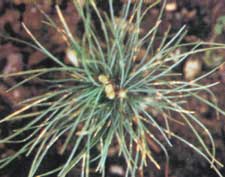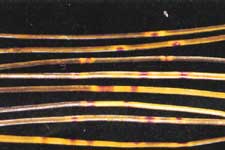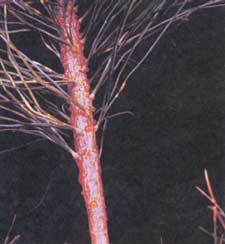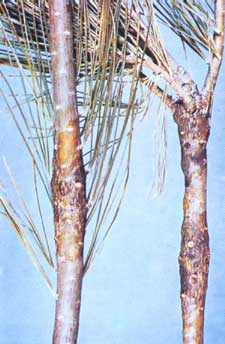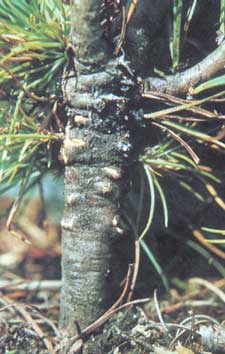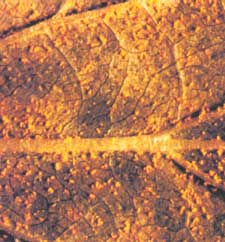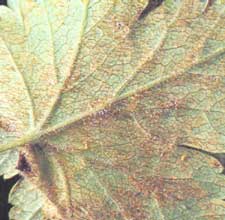White Pine Blister RustRobert E. Patton - Professor of Plant Pathology and Forestry (retired), University of Wisconsin, Madison, WI, and Cordell C.E., Anderson R.L., Hoffard W.H., Landis T.D., Smith R.S. Jr., Toko H.V., 1989. Forest Nursery Pests. USDA Forest Service, Agriculture Handbook No. 680, 184 pp. Hosts White pine blister rust, caused by the fungus Cronartium ribicola, requires two different hosts to complete its life cycle. It infects white, or five-needle, pines and herbaceous plants in the genus Ribes, such as currants and gooseberries. Of North American pines, white-bark, sugar, and western white pines are very susceptible; eastern white pine and most other native species are moderately susceptible. Relatively resistant species include bristlecone, Armand, Swiss stone, and Himalayan blue pines. Species of Ribes vary in susceptiblity. Distribution Introduced from Europe, the fungus has spread over much of the range of our commercially important white pines. In the South, it occurs on pines and Ribes along the Appalachian Mountains in western Virginia, eastern West Virginia, and northwestern North Carolina. It occurs on pine in eastern Tennessee but only on Ribes in northern Georgia. It is present throughout the Northeast and west into Minnesota and Iowa. In the West, it occurs from Jasper National Park in Alberta to southern Idaho, western Montana, and southeastern Wyoming and from British Columbia south into northern California. Damage Seedlings infected by the white pine blister rust fungus seldom die in the nursery, but infected seedlings do not survive following outplanting. Diagnosis
Infection of 2-0 or older seedlings may not produce visible symptoms before they are lifted. Consequently, infected trees may not be detected in cursory inspection of nursery beds, or in routine culling procedures. Ribes - On Ribes, uredinia appear in the summer as small, yellow-orange pustules on the underside of leaves (fig. 24-6) and produce granular clumps of orange urediniospores. During late summer and early fall, brown, hairlike telial columns up to 2 cm long appear on the underside of the leaf, either from the uredinia or directly from the leaf tissue (fig. 24-7). The abundance of telia on Ribes leaves is a good indicator of the potential blister rust hazard to nearby white pine seedlings. Biology Basidiospores, produced on the telia and carried by the wind, infect pine needles through the stomata. The fungus grows from the pine needle into inner bark tissues of the stem and continues to advance as long as the host remains alive. Pycnia produce tiny, pear-shaped pycniospores that are exuded in a drop of yellow-orange fluid. The pycniopores serve only a sexual function. In the spring, following the production of pycnia, aeciospores are produced that may be carried on the wind for long distances. The aeciospores begin the infection cycle on Ribes. Urediniospores are produced about 1 to 3 weeks after the infection of the Ribes leaf. Urediniospores spread and intensify the rust on Ribes. Later in the summer or in the early fall, teliospores, which make up the telial columns, germinate during wet weather and when temperatures are below 68 0F. The teliospores produce delicate, globose basidiospores. These infect pine needles and, thus, complete the life cycle. Control Prevention - Use seed from rust-resistant sources, which affords the most effective, long-term control of the disease in high-hazard areas. White pine blister rust control in nurseries is largely dependent upon the occurrence of the alternate host (Ribes) in the vicinity of the nursery. When necessary, locate the nursery outside Ribes habitat areas or eradicate Ribes within zones around the nursery. Recommendations concerning the width of Ribes eradication zones vary considerably: zones 1,000 to 1,500 feet wide are commonly used, although zones of 600 to 900 feet may be adequate in many cases. Cultural - In high-hazard areas, cull all infected seedlings. Selected References Benedict, Warren V. 1981 History of white pine blister rust control-a personal account. FS 355. Washington. DC: U.S. Department of Agriculture. Forest Service. 47 p. McDonald, G.I. 1979. Resistance of western white pine to blister rust: a foundation for integrated control. Res. Note INT-252. Odgen, UT: U.S. Department of Agriculture. Forest Service. Intermountain Forest and Range Experiment Station. 5 p. Van Arsdell, E.P. 1972. Environment in relation to white pine blister rust infection. In: Biology of rust resistance in forest trees. Misc. PubI. 1221. Washington. DC: U.S. Department of Agriculture. Forest Service: 479-493. |
Forest Pests: Insects, Diseases & Other Damage Agents |

|
|
